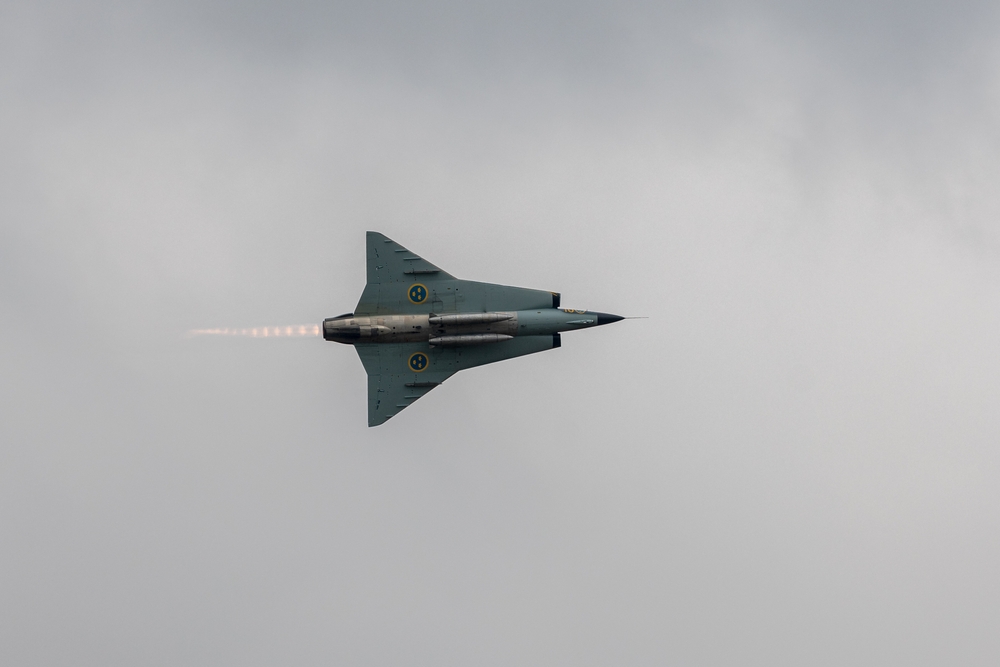China has showcased its second fifth-generation stealth fighter jet, the Shenyang J-35, at its largest air show, positioning itself as the only country aside from the United States with more than one fifth-generation fighter jet. The debut of the J-35 underscores China’s growing ambitions in military aviation, highlighting its intent to compete with U.S. aerial capabilities, particularly in the Indo-Pacific region.
The J-35, a twin-engine, single-seater supersonic jet designed for multirole missions, follows the J-20 as China’s latest development in stealth aircraft. With its appearance at the Zhuhai air show, the J-35 signals readiness for deployment and a potential strategic shift for the People’s Liberation Army (PLA) Air Force and Navy.
Design Parallels with U.S. Counterparts
Notably, the J-35 bears design similarities to the U.S. Lockheed Martin F-35, although it features twin engines compared to the single-engine F-35. This follows a pattern of design inspiration from American military jets. For example, the J-20’s resemblance to the U.S. F-22 Raptor, and the Chengdu J-10’s similarity to the F-16, have led analysts to note China’s tendency to emulate Western aircraft designs.
Global Times, a publication known for aligning with the Chinese Communist Party, stated, “The aircraft could enhance the country’s integrated combat capabilities,” positioning the J-35 as a key asset in China’s growing arsenal.
Capabilities and Strategic Goals
The J-35’s mission profile emphasizes stealth and counter-stealth roles, focusing on air superiority, engaging hostile fourth and fifth-generation aircraft, intercepting missiles, and neutralizing ground and surface air defenses. China has plans to induct the J-35 into both the Air Force and Navy, mirroring the U.S. approach with its F-35 variants: the F-35A for the Air Force, the F-35B for the Marine Corps with vertical landing capabilities, and the carrier-capable F-35C for the Navy.
China’s largest aircraft carrier, the Fujian, which embarked on sea trials earlier this year, is expected to be a launch platform for the J-35. The Fujian features the Electromagnetic Aircraft Launch System (EMALS), a cutting-edge technology also seen on the U.S. Navy’s USS Gerald R. Ford.
Global Reactions and Comparisons
The U.S. Department of Defense has noted China’s advancements in naval aviation, stating in a report that “China may be developing a carrier-capable variant of its FC-31/J-31 fifth-generation stealth fighter to complement or succeed the J-15 on catapult-equipped PLA carriers.” The report also highlighted China’s ongoing development of the KJ-600, an airborne early warning aircraft akin to the U.S. E-2 Hawkeye, as well as its stealth drone programs.
The competition between China and the U.S. extends beyond fighter jets to missile capabilities. The U.S. recently deployed its AIM-174B long-range air-to-air missile, with an operational range of 400 km, potentially altering the strategic balance in the Indo-Pacific region.
The Broader Impact of Stealth Innovations
China’s unveiling of the J-35 comes alongside its debut of the world’s first twin-seat variant of a stealth aircraft, the J-20, showcasing in-flight diamond formations at the air show. The Russian Su-57, another fifth-generation fighter jet, also made an appearance, underscoring the event’s significance as a platform for demonstrating global advancements in stealth technology.
The air show featured a new addition: a dedicated drone zone, spotlighting the growing role of unmanned technology in modern warfare. The Russia-Ukraine war has shown the world the strategic importance of drones, highlighting how they can level the playing field for nations with asymmetric military strength.
Naval and Technological Advancements
China’s reveal of the unmanned surface vessel known as the “Killer Whale” reflects its broader military aspirations. The dual diesel and electric-propelled ship, capable of launching various weaponry and supporting helicopter operations, emphasizes China’s commitment to autonomous naval technology. The U.S. has also been active in this field, recently completing Pacific trials with its unmanned surface fleet.
India’s Advanced Combat Aircraft Plans
Meanwhile, India is progressing with its Advanced Medium Combat Aircraft (AMCA) program, aiming to develop a 5.5-generation stealth fighter expected for induction by 2035. According to Dr. Samir V. Kamat, chairman of India’s Defence Research and Development Organisation (DRDO), the AMCA represents India’s push to join the select group of nations with advanced stealth capabilities. The Indian Air Force’s most recent induction, the 4.5-generation Rafale, currently operates from bases in Ambala, Haryana, and Hashimara, Assam, close to strategic locations like the Line of Actual Control with China.
The debut of the J-35 and the advancements showcased at China’s largest air show underscore its drive to position itself as a formidable force in aerial and naval power. As tensions and military competition in the Indo-Pacific continue to rise, these developments signify not only a regional power shift but also set the stage for evolving dynamics in global military aviation.







